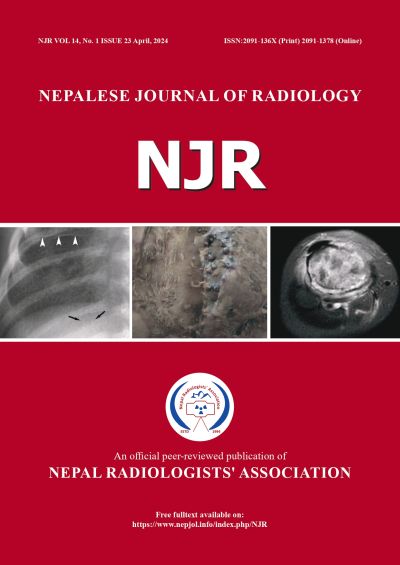Role of Sonoelastography in Differentiating Benign and Malignant Breast Lesions: A Prospective Study Comparing Elasticity Contrast Index and Tsukuba Score
DOI:
https://doi.org/10.3126/njr.v14i1.64625Keywords:
Breast, Elasticity, Elasticity Imaging Techniques, Sonoelastography, UltrasonographyAbstract
Introduction: Breast cancer is the most common cancer occurring in women globally which is potentially curable if detected early. Ultrasound elastography is a dynamic technique that estimates tissue stiffness to differentiate between benign and malignant masses. Our study aimed to determine and compare the diagnostic accuracy of B mode Sonography, Elasticity contrast index, and Tsukuba score in differentiating malignant and benign breast masses.
Methods: This was a prospective cross-sectional study done including 110 lesions in 102 patients in the age group of 15-73 years. The solid breast lesions seen on sonography were categorized according to the American College of Radiology Breast Imaging Reporting and Data System (ACR BI-RADS) and further evaluated with elastography using both Elasticity Contrast Index (ECI) and Tsukuba score with pathological diagnosis taken as the gold standard. The cut-off value of ECI was obtained. The diagnostic accuracy of B-mode sonography, ECI, and Tsukuba score was compared.
Results: We found that B-mode sonography had a sensitivity of 85.7%, specificity of 100%, and accuracy of 96.9 %. The accuracy of Tsukuba scores for differentiating benign and malignant lesions was 81.2%. The cut-off value of ECI obtained was 2.8 and the accuracy was 81.8%. A statistically significant correlation (p < 0.05) existed between sonographic diagnosis, ECI, and Tsukuba score.
Conclusions: B mode sonography had the highest diagnostic accuracy while ECI and Tsukuba scores were comparable. ECI can be used for breast masses using a cut-off of 2.8 to differentiate benign from malignant.
Downloads
Downloads
Published
How to Cite
Issue
Section
License
Copyright (c) 2024 Nepalese Journal of Radiology

This work is licensed under a Creative Commons Attribution-NonCommercial 4.0 International License.
This license enables reusers to distribute, remix, adapt, and build upon the material in any medium or format, so long as attribution is given to the creator. The license allows for commercial use.




